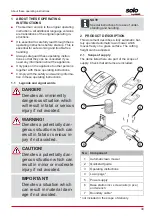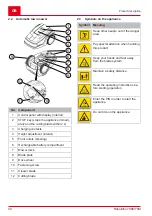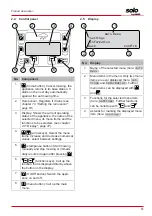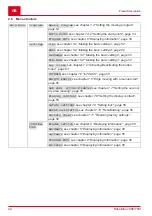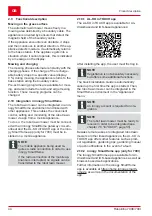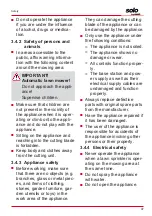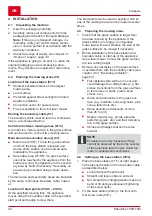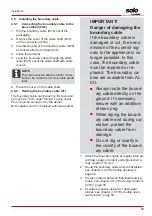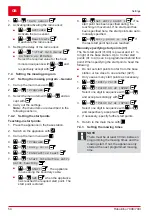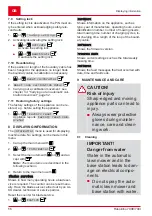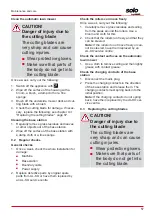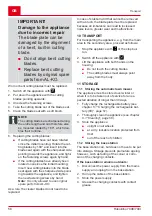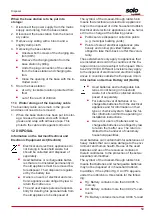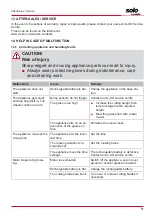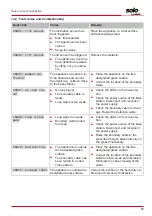
GB
48
Robolinho 700E/700I
Installation
4
INSTALLATION
4.1
Unpacking the machine
1.
Open the packaging carefully.
2. Carefully remove all components from the
packaging and check for transport damage.
Note:
If there is any transport damage, im-
mediately notify your AL-KO dealer, techni-
cian or service partner in accordance with the
warranty conditions.
3. Check the scope of supply, see
chapter 2.1
.
If the appliance is going to be sent on, retain the
original packaging and accompanying docu-
ments. They will also be required for return ship-
ment.
4.2
Planning the mowing areas (01)
Location of the base station (01/1)
■
Shortest possible distance to the largest
mowing area
■
Level surface
■
Protected against direct sunlight and harsh
weather conditions
■
Connection option for power source
■
Free accessibility to the robot lawn mower
Routing the boundary cable (01)
The boundary cable must be laid in a continuous
loop in a clockwise direction.
Corridors between mowing areas (01/h)
A corridor is a narrow section in the grass surface
and can be used to connect two mowing areas.
Main area and secondary area(s) (01)
■
Main area (01/HF): This is the grass surface
on which the base station is located and
whose entire surface can be mowed auto-
matically by the appliance.
■
Secondary area (01/NF): If a grass surface
cannot be reached by the appliance from the
main area, carry the appliance to the second-
ary area by hand if necessary. Secondary ar-
eas can be processed using manual opera-
tion.
The main area and secondary areas are bounded
by the same continuous boundary cable, howev-
er.
Location of start points (01/X0 – 01/X3)
At the specified mowing time, the appliance
moves along the boundary cable to the specified
start point and begins to mow there.
The start points can be used to specify which ar-
eas of the mowing area are to be mowed several
times.
4.3
Preparing the mowing areas
1.
Check that the grass surface is larger than
the area covered by the appliance. If the
grass surface is too large, an irregularly
mown lawn will result. Reduce the size of the
grass surface to be mowed if necessary.
2.
Before installation of the base station and
boundary cable or start-up of the appliance:
Use a lawn mower to mow the grass surface
to a low cutting height.
3.
Remove any obstacles on the grass surface
or exclude them with the boundary cable (see
chapter 4.5.3 "Excluding obstacles",
page 50
■
Flat obstacles that will be run over and
could damage the cutting blade (e.g. flat
stones, transitions from the grass surface
to the terrace or paths, plates, kerb-
stones, etc.)
■
Holes and protrusions in the grass sur-
face (e.g. molehills, burrowing holes, pine
cones, fallen fruit, etc.)
■
Steep ascents and descents of more
than 45 % (24°)
■
Bodies of water (e.g. ponds, streams,
swimming pools, etc.) and their demarca-
tion to the grass surface
■
Shrubs and hedges that can become
broader
NOTE
Exclusions are only necessary if they
cannot be detected by the bump sensors
of the automatic lawn mower. Avoid too
many or unnecessary exclusions.
4.4
Setting up the base station (03/a)
1.
Place the base station (01/1) at right angles
to the planned location of the boundary cable
as described below:
■
Level (check with spirit level)
■
Straight and level entrance and exit
■
Not arched (the charging station must not
bend or tilt during subsequent tightening
of the screw nails)
2.
Fix the base station (03/2) to the floor with
four screw nails (03/1).
Содержание 127547
Страница 67: ...67...






